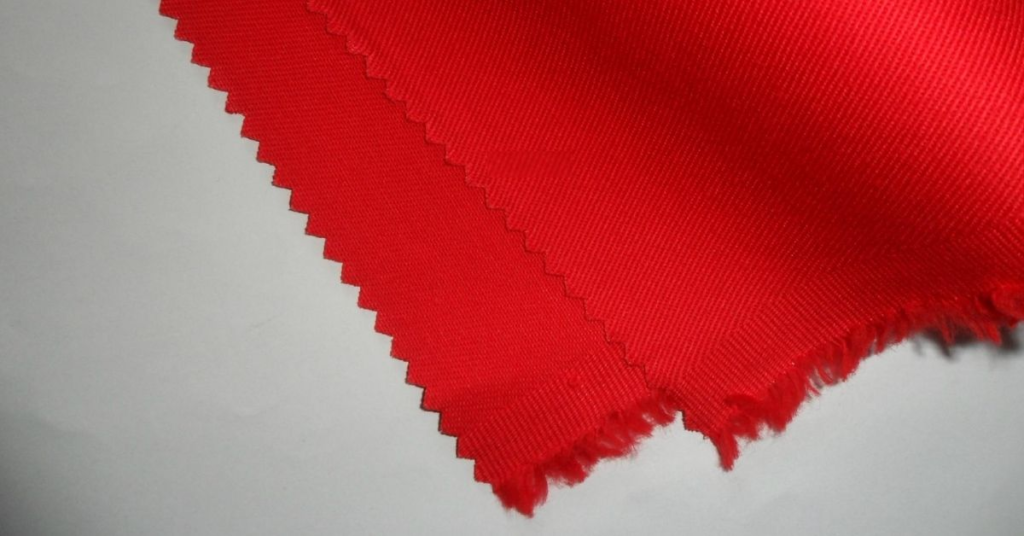Any person in the field of fashion, textile, or product design needs to understand the difference between TC and TR fabrics. The selection of the fabric influences durability, comfort, care, and cost, and it is an important choice both in business and personal concerns. This guide will discuss TC and TR fabric in detail including their composition, properties, types, applications, and manufacturing process. At the end, you will have the understanding to compare, pick and use these fabrics with confidence.
What is TC Fabric?
Terylene Cotton, also known as TC fabric, is a mixture of polyester and cotton that has a combination of synthetic power and natural comfort. It was initially introduced in the mid 20 th century when polyester, also known as Terylene was combined with cotton to enhance fabric strength. Approximately 1520 percent of the world workwear textiles consist of TC fabric by 2025. You see uniforms, shirts or industrial clothes, you are likely to see TC at work.

What is TR Fabric?
Terylene Rayon, or TR fabric, is a mixture of polyester and rayon which provides you with strength and a graceful drape. It was initially developed in the early 1900s through viscose rayon breakthroughs and later became refined in the 1970s with the addition of polyester to improve stability. TR fabric is dominating fashion markets these days. Its importance in the global market is also on the rise as it comprises approximately 10-15 percent of the blended dress fabric, particularly in suiting and summer wear by 2025.

Composition of TC Fabric
TC fabric is typically 65 percent polyester and 35 percent cotton, but 60/40 and 70/30 ratios are also available. Polyester, a product of petroleum-based polymers, provides resistance to wrinkles and fast drying. Cotton is a natural cellulose fiber which contributes to softness and breathability. With increased polyester content you have durability at the cost of airflow. The fibers are linked in a physical and chemical way, and balance between strength and comfort is achieved. The quality of the TC fabric can also be compared based on the thread count and fineness of the yarn.
Composition of TR Fabric
TR dress is typically made of 67 percent polyester and 33 percent rayon, though 50/50 blend is also available to add drape. The polyester provides strength and makes the fabric maintain its shape. Rayon is a regenerated cellulose that contributes to softness, sheen, and absorbency. With more rayon, it flows better but tends to shrink. Polyester molecules are also bonded, and the looser structure of rayon makes it comfortable. Thickness can be determined by denier and appearance by luster which can determine the type of fabric you choose.
Types of TC Fabric
- TC Twill Fabric: This one is based on the diagonal weave that provides the fabric with the structure and resistance against abrasion. The polyester-cotton mix is evenly balanced and gives strength and durability. You can frequently find it in the trousers, uniforms, and working clothes where the strength is the most important thing.
- TC Cotton Fabric: In this case, the percentage of cotton may be up to 50, making it soft and breathable. Polyester makes it wrinkle free and cotton makes it comfortable. You will find it to be a better fit with casual shirts and day to day wear when you want an easy-to-care garment with extra softness.
- TC Fleece: This one is brushed inside, which traps the warmth but is light in weight. The polyester gives strength and the cotton enhances comfort. You will wear it in hoodies, jackets and sweatshirts, which are ideal during colder weather.
- TC Jersey: This is an item that is knitted and thus it has natural stretch and flexibility. Polyester will help in maintaining the shape, and cotton will make it breathable. You will find it in t-shirts and active wear which require comfort and mobility.
- TC Terry: This one is very absorbent and is soft with looped piles. The combination is one that is both durable and comfortable. You will apply it to towels, robes as well as loungewear which requires moisture management.
- New Variants: Recycled polyester TC fabrics are taking off in 2025. They are sustainable and comfortable and help make environmentally friendly decisions. They will be in sustainable fashion and home textiles.
Types of TR Fabric
- Polyester Rayon Blends: This is a regular TR fabric that is composed of approximately 67% polyester and 33% rayon. It provides moderate shine, toughness, and longevity. It is a popular type of suiting, as well as daily office wear, because it maintains shape without being uncomfortable.
- Polyester Viscose Blends: This subtype is found when viscose takes the place of ordinary rayon, mixed with polyester in comparable proportions. It takes in dyes more, producing deeper, richer colors. this is a fabric that does not wrinkle easily and could be used in dresses, skirts and formal clothes that require fashion and comfort.
- Specialty Variations: You will find TR fabrics with spandex added to them to provide stretch or woven lighter to create chiffon-like effects. These combinations are flexible and flowing, and they can be used with formals, blouses, and evening outfits.
- 2025 Trends: You now have eco-viscose blends which lower the environmental footprint of rayon. They combine eco-friendly viscose with polyester stability, which is ideal in brands that aim at environment-friendly consumers.
Properties of TC Fabric
TC fabric is a good compromise between durability and comfort that you can count on both in workwear and comfort clothes. It has a tensile strength of 2.65 to 5.7 cN/dtex which is resistant to wear and abrasion and is second only to nylon in toughness. You will see how easily it keeps its shape, due to the wrinkle and shrink resistance of polyester, even after being washed many times. Cotton fibers introduce hydrophilicity whereas polyester provides wicking rendering it appropriate in sportswear.
Comfort is average-breathable enough to be used on a regular basis but not as smooth as natural fibers. You have good UV protection, excellent colorfastness, and weak piling, with a modulus of elasticity of 22-141 cN/dtex. But you warn you know it may be stuffy in damp weather. By selecting TC fabric you are selecting strength, low maintenance and regular performance, but comfort can change depending on the conditions.
Properties of TR Fabric
TR fabric is strong, soft, and elegant, a combination that you can count on to provide long-lasting wear. Polyester as the leading fiber provides high impact strength and durability, which is four times higher than nylon and twenty times greater than viscose. The TR fabric has a graceful flow due to the addition of superior drape and elasticity that allow the fabric to recover wrinkles at only 5-6 percent elongation. You will also have improved breathability and moisture capacity compared to TC, which keeps clothes cool and airy.
Its hand-feel is silky and makes it more comfortable, and its lightfastness is strong to guarantee the permanence of color. It is a useful day-to-day use as it is resistant to chemicals, acids, and bleaches. TR fabrics are also resistant to mildew and corrosion which last longer and save you money. Nonetheless, you ought to be aware of its disadvantages, TR can be not as comfortable as pure cotton and can be rather statical when there is no moisture. TR is a compromise of performance, style and comfort.
How TC Fabric is Made: Step-by-Step Process?
Step 1: Fiber Preparation
Preparation of the raw fibers is the initial process. You take polyester (Terylene) and cotton, then clean and work them to get them clean of any dirt or seeds or any other wax. The fibers are made smooth and ready to mix through carding. Without adequate preparation the end product loses its strength and consistency.
Step 2: Blending
Next comes blending. You mix polyester and cotton by fiber blending, in which the two are mixed closely together and then spun, or by yarn blending, in which different strands of yarn are twisted together. The desired polyester and cotton content of most TC fabrics is 60 to 70 percent and 30 to 40 percent respectively. This ratio will provide you with durability of polyester and comfort of cotton.
Step 3: Spinning
The fibers are pulled into yarn once blended. Ring spinning may be applied to finer yarns or open-end spinning to coarse ones. The spinning process guarantees evenness and firmness, which are essential in case you wish the fabric to survive the everyday wear and washing.
Step 4: Weaving/Knitting
The yarns are woven or knitted into a piece. You can select plain weave to give a smooth finish or twill weave to give some texture and extra strength. Knitting is suitable when using stretchy materials such as jerseys. This step determines the feel and performance of the fabric.
Step 5: Scouring and Preparation
You have to scour the fabric before dyeing. This is done by washing it in alkaline baths to eliminate natural oils and dirt and processing residues. Omission of this step influences the dye uptake and brightness of fabric.
Step 6: Dyeing
The process of dyeing TC fabric is complicated due to the differences in reactions of polyester and cotton. The first step involves dyeing polyester with high-temperature disperse dyes and the second stage involves clearing away excess dye by reduction. Reactive dyes are used to dye the cotton part. Single bath techniques are gaining popularity today, consuming less time, less cost and increasing efficiency.
Step 7: Finishing
After dyeing, the cloth is finished. You heat-set it to make it dimensionally stable, and add softening agents, and occasionally wrinkle resistance. Completion is guaranteed to produce a professional looking and comfortable fabric.
Step 8: Rolling and Quality Control
Lastly, you check the cloth against flaws, gauge strength, and check the color. Once approved, it is rolled and packed to be distributed. This will ensure that you get a fabric that is of industry standard and customer expectation.
How TR Fabric is Made: Step-by-Step?
Step 1: Fiber Preparation
In order to make TR fabric, rayon is first made by the viscose process. To create rayon fibers, you dissolve cellulose in sodium hydroxide and carbon disulfide to create a viscous solution and extrude it into an acid bath. Meanwhile, pre-spun polyester is made available to blend. Before proceeding to the next stage, you must have both of these parts prepared.
Step 2: Blending
Then you add polyester and rayon in a common proportion of 67/33. This mixing may be either at the fiber level to create an intimate mix or at the yarn level to create parallel distribution. Blending is done properly to provide consistency, and balance of strength and drape, the characteristics of TR fabric.
Step 3: Spinning
Once mixed, you spin the fibers into yarn. The blended dope is forced out in continuous filaments, and then the feel is right-texturized. You can select the spinning technique based on the requirement of crisp suiting or soft flowing textile.
Step 4: Weaving/Knitting
When the spinning is finished, you weave or knit the yarns into cloth. Smooth suiting is usually done on shuttleless looms, and jersey knits are selected to wear lightweight clothes. The way it is built has direct effects on the performance of the fabric in everyday application.
Step 5: Pre-Treatment
Prior to dyeing, you treat the cloth. The rayon fraction is occasionally mercerized to provide lustre and strength. You also wipe the cloth to take away the oils and dirt of spinning. This guarantees superior uptake of dye and uniform finishing in the future.
Step 6: Dyeing
At this step, you stain the polyester using disperse dyes in the range of 130 -140 C. You then proceed to dissolve out the surplus dyes and then color the rayon part with either direct or reactive dyes in acid bath or alkaline bath. Single-bath dyeing is now being embraced in many mills to save time and save money.
Step 7: Finishing
Here you put the finishing touches on the cloth. You schedule it to a clean finish, treat it with anti-static agents, and occasionally with crease-resistant resins. These measures simplify the wearing and maintenance of TR fabric.
Step 8: Inspection and Packaging
Lastly, you check the cloths on strength, color consistency, and defects. Today, eco-friendly finishing agents are common in order to comply with sustainability standards. Upon approval, the fabric is rolled and sent to be distributed.
Uses and Applications of TC vs TR
Uses of TC Fabric
TC fabric is highly popular in uniforms, workwear, and bedding due to their durability and resistance to wrinkles. When you use TC to order corporate t-shirts or pants, you can get a business appearance that lasts. TC blends also can be trusted with upholstery and curtains when strength and easy care are of the essence.
Uses of TR Fabric
TR fabric should be used when softness and drape are required. It is effective with dresses, suits and linings. When you are making evening clothes or summer tops, TR fabric provides the garments with a smooth look and a breathable feel. You also have the benefit of its smooth texture, which is more desirable.
Cross-Industry Applications
Both TC and TR fabrics are not limited to fashion. They are used in car interiors in the form of seat covers and trims. They will also be available in medical scrubs, where comfort and durability matter as well.
Care Instructions for TC and TR fabric
Care Instructions for TC Fabric
TC fabric is easy to maintain due to a polyester-cotton mix. Wash it in warm water using a normal machine cycle. You do not have to use rough detergents because the material does not get dirty easily and does not fade away the color. Wash and tumble dry on low heat or air dry it. Wrinkles are not very common, and thus, you need light ironing only when you desire a sharp appearance. These steps will prolong the life of your uniforms, bedding or casual wear.
Care Instructions for TR Fabric
TR fabric should be treated more carefully so as to maintain its silk drape and softness. Wash in a delicate or gentle cycle with cold water always. Wash with light detergent and do not use bleach in order to preserve rayon fibers. Drying under air is the best method because the texture may be destroyed by heat. In case ironing is required, set it at low-heat levels with a pressing cloth. Using TR fabric properly, you maintain the dresses, suits, and linings beautiful and extended.
Cost Analysis for TC and TR fabric
Pricing is a major factor in the choice when it comes to TC and TR fabric. TC fabric sells between 1.50-3.50 per yard with the cheapest twill at 1.10 and the most expensive poplin at 3.99. TR fabric has a slight increase with an average of 2.00 to 4.20 per yard depending on the grade and quality of the blends. You must also consider width and finishing which increase the costs. When you purchase in large quantities or when you get suppliers in Asia, you can get cheaper prices.
Comprehensive Comparison of TC and TR Fabrics
| Aspect | TC Fabric (Polyester-Cotton) | TR Fabric (Polyester-Rayon) |
Composition | 65% Polyester / 35% Cotton | 67% Polyester / 33% Rayon |
Key Properties | High durability, wrinkle-resistant, moisture-wicking | Excellent drape, breathable, silky texture |
Strength | 2.6-5.7 cN/dtex; abrasion-resistant | 5.6-8.0 cN/dtex high-strength; elastic recovery |
Comfort | Moderate breathability; sturdy feel | Soft, airy; luxurious hand |
Uses | Uniforms, workwear, casual | Dresses, suiting, eveningwear |
Care | Easy: Machine wash, low tumble | Delicate: Hand/gentle wash, air dry |
Cost per Yard (2025) | $1.50 – $3.50 | $2.00 – $4.20 |
Eco-Impact | Moderate (cotton water-intensive) | Higher (rayon chemical process) |
Balanced View: When to choose TC and TR fabric?
TC fabric should be selected when the durability, resistance to wrinkles and easy care are important such as in uniforms, workwear and bedding. TR fabric is preferable in cases where softness, drape, and style are the main factors, so it is suitable in dresses, blouses and formal clothes. TC is best in case cost efficiency and strength are your determinants. TR is a better choice when comfort, style and a luxurious feel are your objectives. The correct decision is determined by the ability to compromise between functionality, cost and aesthetics.
Conclusion
To sum up, TC and TR fabrics are two multifunctional textile materials that can be used to meet different fashion and industrial demands. TC fabric is strong, resistant to wrinkling, and cost-effective and is the uniforms, workwear, and practical cloth choice. TR fabric, however, is a bright spot in softness, drape and elegance, ideal in fashion-sensitive and formal wear. Their variations are what will guide you to make wiser fabric choices. Sample and compare textures and match them with your project requirements to attain functionality and style.


